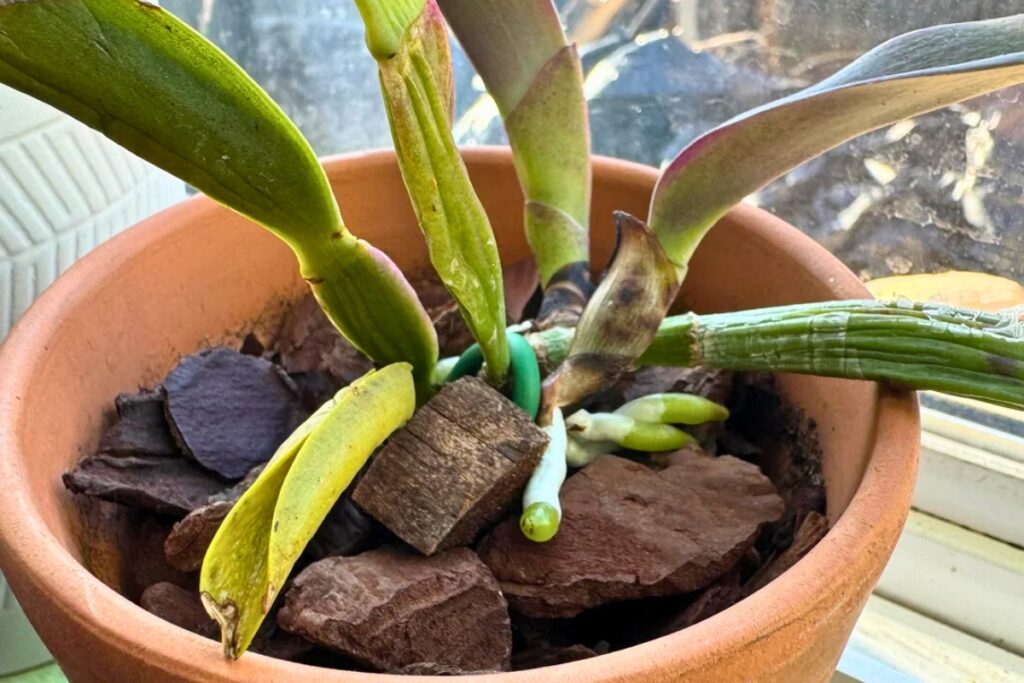Just like a temperamental diva who needs the perfect conditions to perform, your Cattleya orchid will signal its discontent through various symptoms. You’ll notice these stunning plants communicate their needs through yellowing leaves, withered blooms, or lackluster growth. Whether you’re battling root rot or dealing with stubborn buds that won’t open, there’s a systematic approach to diagnosing and fixing each issue. Let’s explore the most effective solutions to keep your orchid performing at its peak.

Contents
- 1 Yellowing Leaves and Their Root Causes
- 2 Preventing and Treating Root Rot
- 3 Addressing Failed or Weak Blooming
- 4 Managing Temperature Stress Symptoms
- 5 Solving Common Pest Infestations
- 6 Correcting Light Exposure Problems
- 7 Proper Watering Techniques and Schedules
- 8 Resolving Nutrient Deficiencies
- 9 Repotting and Media Selection Guidelines
- 10 Disease Prevention and Treatment Strategies
Yellowing Leaves and Their Root Causes
Yellow leaves on your Cattleya orchid often signal an underlying issue that needs immediate attention. The most common causes include overwatering, insufficient light, and nutrient deficiencies, particularly nitrogen and magnesium.
If you’re watering more than once every 7-10 days, you’ll need to cut back. Your orchid’s roots can rot when they’re constantly wet, leading to those tell-tale yellow leaves. For lighting issues, make certain your plant receives 4-6 hours of bright, indirect sunlight daily.
When nutrient deficiency is the culprit, you’ll notice yellowing starting at the leaf tips. Apply a balanced 20-20-20 orchid fertilizer every two weeks during the growing season.

Preventing and Treating Root Rot
Because root rot can quickly destroy your Cattleya orchid’s entire root system, catching it early is essential for your plant’s survival. Check for brown, mushy roots weekly and trim affected areas with sterilized scissors, cutting 1/4 inch into healthy tissue.
To prevent root rot, guarantee proper drainage by using a well-aerated orchid mix and pots with multiple drainage holes. Water only when the top 2 inches of media feel dry, typically every 7-10 days.
If you find extensive rot, repot immediately in fresh media after removing all damaged roots. Spray the remaining healthy roots with 3% hydrogen peroxide solution, and reduce watering frequency by 30% during recovery.
Addressing Failed or Weak Blooming
If your Cattleya orchid isn’t blooming well, you’ll need to focus on two key areas – proper lighting and fertilization, which are essential for flower production. Your orchid requires bright, indirect light for 5-6 hours daily, along with balanced fertilizer (20-20-20) applied at quarter-strength every two weeks during the growing season. Additionally, maintaining temperatures between 65-80°F and humidity levels of 40-60% will greatly improve your orchid’s blooming potential, as these environmental factors directly influence flower development.
Light and Fertilizer Problems
Poor blooming in Cattleya orchids often stems from inadequate light exposure or improper fertilization schedules. You’ll want to make certain your orchid receives 4-6 hours of bright, indirect sunlight daily, ideally from an east-facing window or under grow lights positioned 12-18 inches above the foliage.
For fertilization, use a balanced 20-20-20 formula at quarter-strength every two weeks during the growing season. If your orchid’s leaves are dark green, that’s a sign it’s getting too little light. Pale yellow leaves indicate too much light or nutrient deficiency, which you can correct by adjusting light exposure and implementing a regular feeding schedule.
Temperature and Humidity Issues
While Cattleya orchids can tolerate a range of conditions, they’ll struggle to bloom when temperature and humidity levels aren’t within their preferred zones.
For ideal flowering, maintain daytime temperatures between 70-85°F and nighttime temperatures between 55-65°F. Your orchids need this 10-15°F daily temperature drop to trigger blooming. If temperatures stay too consistent, they won’t set flower spikes.
Keep humidity between 50-70% using a humidity tray or small humidifier. When humidity drops below 40%, you’ll notice wrinkled leaves and bud blast, where flower buds drop before opening. In winter, place plants away from heating vents that can create hot, dry spots.
Managing Temperature Stress Symptoms
Your Cattleya orchid will show clear warning signs when it’s struggling with temperature stress, including wilted or discolored leaves, bud blast, and shriveled pseudobulbs. You’ll need to watch for these symptoms year-round, as both winter cold snaps below 55°F and summer heat waves above 85°F can trigger serious damage. When you spot temperature-related issues, quick action like adjusting your orchid’s location, modifying ventilation, or adding humidity through misting can help your plant recover and prevent lasting harm.
Identifying Temperature Damage Signs
Recognizing temperature damage in Cattleya orchids requires careful attention to specific visual cues. You’ll notice dark purple spots on leaves when temperatures drop below 50°F, while temperatures above 85°F often cause yellowing and leaf tip burn.
Check the newest growth first, as it’s most susceptible to temperature stress. If you see wrinkled or pitted leaves, your orchid’s likely experiencing cold damage. During hot spells, watch for wilting pseudobulbs and soft, mushy spots on leaves.
The flower buds will tell you a story too – they’ll blast (fail to open) or drop prematurely if they’ve experienced temperature shock within the past 72 hours.
Preventing Cold Weather Issues
Now that you can spot temperature damage, protecting your Cattleya orchids from cold weather becomes straightforward. Start by relocating your plants at least 6 inches away from windows during winter months, and use thermal curtains to block cold drafts at night.
Maintain indoor temperatures between 65-80°F during the day and no lower than 55°F at night. If you’re growing outdoors, bring plants inside when temperatures drop below 50°F. Place a digital thermometer near your orchids to monitor conditions accurately.
For greenhouse growers, install a backup heating system and use heat mats under pots to maintain consistent root temperatures during cold snaps.
Heat Stress Recovery Tips
When temperatures soar above 85°F, Cattleya orchids often show telltale signs of heat stress through wilted leaves and prematurely dropped buds. You’ll need to act quickly to prevent lasting damage to your plant.
Move your orchid to a shadier spot that maintains temperatures between 65-80°F. If you’re growing indoors, position a small fan nearby to increase air circulation, keeping it at least 2 feet away from the plant.
Mist the leaves lightly twice daily, but don’t saturate the growing medium. You can also place the pot on a humidity tray filled with pebbles and water, ensuring the pot bottom doesn’t touch the water directly.
Solving Common Pest Infestations
Despite their hardy nature, Cattleya orchids can fall prey to several common pests that’ll wreak havoc on your plants if left unchecked. The most frequent invaders are spider mites, mealybugs, and scale insects, which you’ll spot on leaves and pseudobulbs.
To combat these pests, first isolate infected plants. Treat spider mites by wiping leaves with 70% isopropyl alcohol every 3 days. For mealybugs, apply neem oil solution (2 tablespoons per gallon of water) weekly.
Scale insects require more persistence – scrape them off manually with a soft toothbrush, then apply insecticidal soap. Repeat treatments for 3 weeks to break the pest life cycle.
Correcting Light Exposure Problems
Proper light exposure stands as the next major challenge in maintaining healthy Cattleya orchids. You’ll know there’s too much light when leaves turn yellowish-green or develop purple-red patches. If leaves appear dark green, they’re not getting enough light.
Position your Cattleyas 6-12 inches from an east or west-facing window, where they’ll receive 4-6 hours of bright, indirect sunlight daily. During summer, protect them with a sheer curtain between 10 AM and 2 PM to prevent leaf burn.
For artificial lighting, place LED grow lights 12-18 inches above the plants for 12-14 hours per day, adjusting height based on leaf response.
Proper Watering Techniques and Schedules
Your Cattleya orchids need clean, room-temperature water that’s low in dissolved solids and chemicals, so filtered or rainwater is ideal. During the growing season, you’ll want to water thoroughly once every 7-10 days, allowing the potting media to dry slightly between waterings. If you’re unsure about timing, stick your finger an inch into the potting mix – if it feels dry at that depth, it’s time to water.
Water Quality Requirements
When growing Cattleya orchids, water quality plays a crucial role in their overall health and blooming success. You’ll want to use water with a pH between 5.5 and 6.5, avoiding softened or chlorinated tap water that can harm your plants.
If you’re using tap water, let it sit out for 24 hours to allow chlorine to dissipate. For better results, collect rainwater or use reverse osmosis water, which doesn’t contain harmful minerals. You can also purchase specific orchid-formulated water treatments.
Test your water’s total dissolved solids (TDS), aiming for readings below 200 ppm. If your readings are higher, consider installing a water filtration system.
Weekly Watering Schedule
While caring for Cattleya orchids requires attention to several factors, establishing the right watering schedule stands as one of the most critical elements for success. You’ll need to water your orchids once every 5-7 days during the growing season, adjusting based on humidity levels and temperature.
Check your orchid’s potting medium before watering – stick your finger an inch deep into the mix. If it’s still moist, wait another day. Water thoroughly in the morning, allowing excess water to drain completely through the pot’s holes.
During winter’s dormant period, reduce watering to every 10-14 days, and always avoid letting water collect in the crown.
Resolving Nutrient Deficiencies
Identifying nutrient deficiencies in Cattleya orchids requires careful observation of the plant’s leaves, stems, and overall growth patterns. You’ll notice yellowing leaves with nitrogen deficiency, while purple-tinged foliage signals phosphorus issues.
To correct these problems, apply a balanced 20-20-20 orchid fertilizer every two weeks during the growing season. Mix 1/4 teaspoon per gallon of water, and don’t forget to flush the potting medium monthly to prevent salt buildup.
If you’re seeing brown leaf tips, that’s often a calcium deficiency. Add 1/2 teaspoon of crushed eggshells to your potting mix, or use a calcium-specific supplement at half strength.
Repotting and Media Selection Guidelines
Proper nutrition sets the foundation for healthy orchids, but even well-fed Cattleyas need the right home to thrive. Select a pot that’s 1-2 inches wider than the root ball, ensuring proper drainage holes and adequate air circulation.
For media, mix 70% medium-grade fir bark with 30% perlite. You’ll need to repot every 2-3 years when the bark starts breaking down or when roots grow over the pot’s edge.
Gently remove your orchid from its old pot, trim any dead roots, and position it so the rhizome sits just below the media’s surface. Don’t plant too deeply – your Cattleya’s roots need to breathe.
Disease Prevention and Treatment Strategies
Since prevention trumps treatment in orchid care, you’ll want to establish good cultural practices from the start. Sterilize all tools with 70% isopropyl alcohol, maintain proper air circulation, and avoid overwatering your Cattleyas.
Watch for early signs of fungal infections, like black spots on leaves or soft, brown areas on pseudobulbs. If you spot these issues, immediately isolate the affected plant and trim away diseased portions with sterilized tools.
For bacterial rot, apply copper-based fungicides every 7-10 days until symptoms resolve. To prevent virus transmission, never reuse potting media and keep infected plants at least 3 feet from healthy ones.
